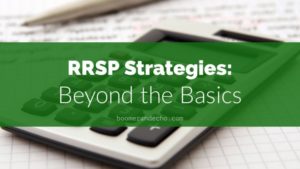 RRSPs are a valuable tool for many taxpayers, which is why they are the backbone of many retirement plans. Getting the most out of your RRSP often involves thinking several years ahead, rather than just when the contribution deadline is looming.
RRSPs are a valuable tool for many taxpayers, which is why they are the backbone of many retirement plans. Getting the most out of your RRSP often involves thinking several years ahead, rather than just when the contribution deadline is looming.
Here are five RRSP strategies to get you thinking beyond the basics:
Claiming RRSP deductions
Most of us claim our RRSP deductions in the tax year we make the contribution, but you don’t have to. In fact, you can choose to deduct only a portion or none at all and carry it forward.
If you expect to move into a higher tax bracket next year from say, a big promotion, or the sale of rental property, you should still make your contribution to take advantage of tax-free compounding. But, it may be worth waiting to claim the deduction the next year (or later) when your marginal rate will be higher and you will get a substantially bigger tax refund.
Level out income
Although RRSPs are designed for retirement savings, sometimes it’s useful to use the money ahead of time, even though you give up years of tax deferred growth. If your income varies quite a bit from year to year, or if you decide to take a year off to write your book or go back to school, you could sock away as much extra RRSP money as you can during your higher earning years and withdraw (and pay the lower tax) in the leaner years.
If you consider this strategy, remember that you still need to keep some RRSP funds intact for when you’re finally done working.
Pre-retirement fill-up
If you are approaching retirement, have lots of unused contribution room, and expect to be in a lower tax bracket when you retire, consider contributing as much as you can during your last good income year, even if you plan to take some out shortly thereafter. If funds are tight, consider an RRSP loan.
Or, instead, withdraw money from your TFSA to make this final RRSP contribution before the end of the year.
Post-retirement contribution
After you retire, your unused contribution room doesn’t disappear. You could continue to make contributions to your own RRSP until the end of the year you turn 71.
Why would you want to do that at a time when you’re thinking more of making withdrawals?
- If you are liquidating assets that would push you into a higher tax bracket such as the family cottage, or shares in a private company.
- If your income in early retirement is more than you expect to have in your later years, such as if you’re working part-time.
Spousal RRSPs
Spousal RRSPs are a form of income splitting, designed mainly for single-income families or those that have a large disparity in income.
If you get your timing right, withdrawals will be taxed in the receiving spouse’s hands, and if that spouse does not earn any other income, may be completely tax free.
Note that you have to completely turn off the funding two full calendar years before starting withdrawals, so it makes sense to always have your contribution in by the end of the year. (e.g. If you make your last contribution by December 2017, your spouse can withdraw as early as January 2020. If you wait until January 2018 to make the contribution, the withdrawal can’t be made until January 2021.)
If you have the available contribution room, you can keep making spousal contributions even after the year you turn 71, up until your spouse reaches that milestone.
If there is a significant age difference between spouses, it’s possible that someone in their 80’s and beyond can still put money into a spousal plan. The older spouse might use his or her minimum required RRIF payment each year to fund an identically sized spousal RRSP contribution. Not only would the contribution offset the tax hit from the RRIF payment, the money would continue to compound until the spouse opens his or her own RRIF.
For couples planning to retire at different times, this technique can be a good way to fund an early retirement for one of them.
 Marie Engen is the “Boomer” half of Boomer & Echo. In addition to being co-author of the website, Marie is a fee-only financial planner based in Kelowna, B.C. This article originally ran at the Boomer & Echo site on Nov. 14, 2017 and is republished here with permission.
Marie Engen is the “Boomer” half of Boomer & Echo. In addition to being co-author of the website, Marie is a fee-only financial planner based in Kelowna, B.C. This article originally ran at the Boomer & Echo site on Nov. 14, 2017 and is republished here with permission.

